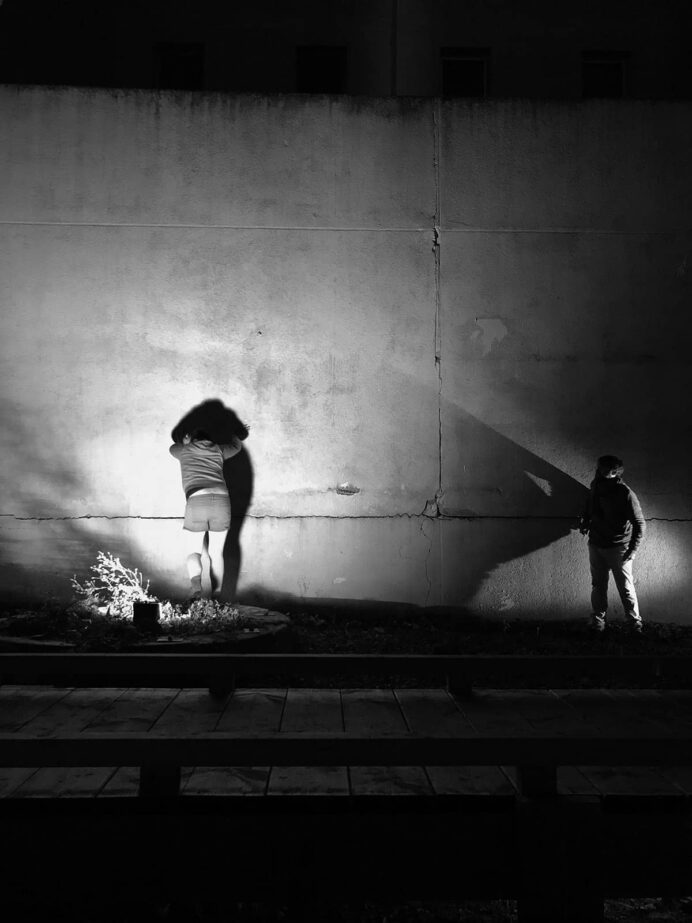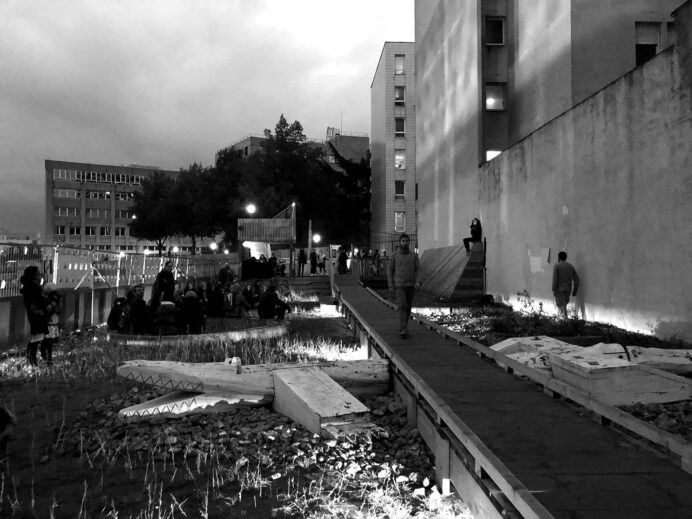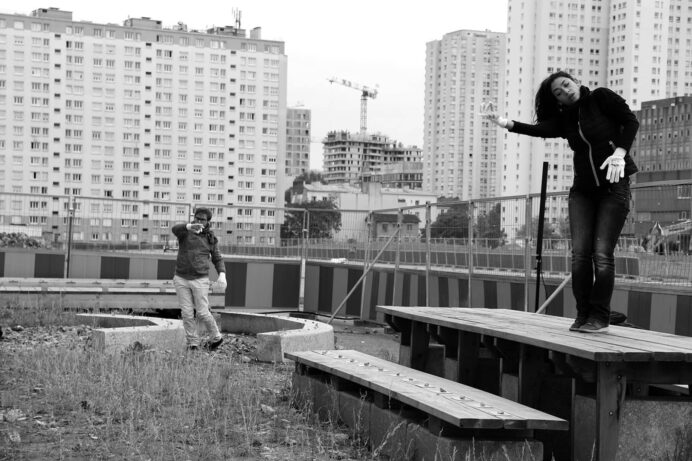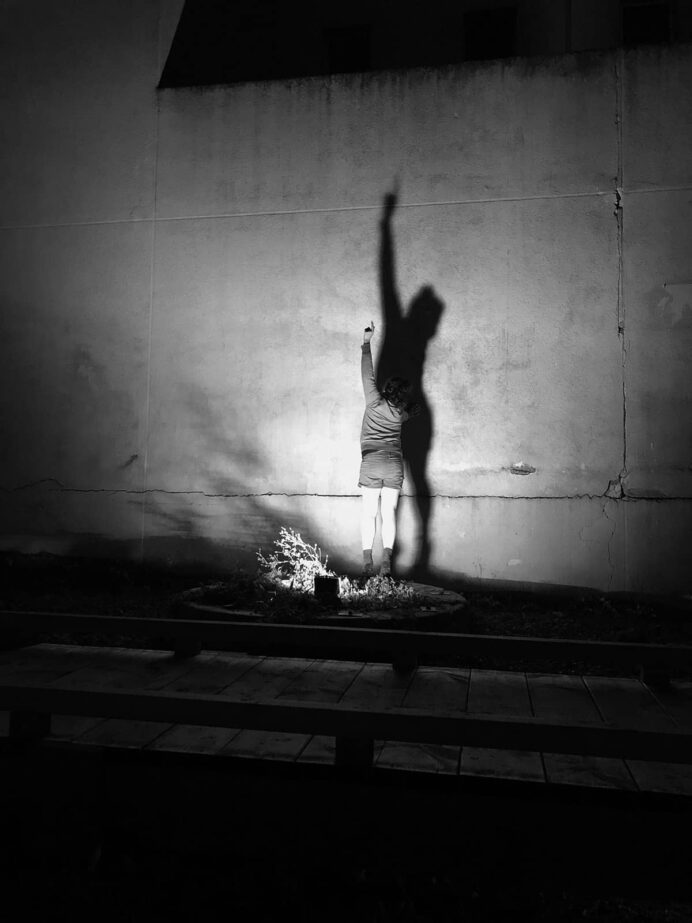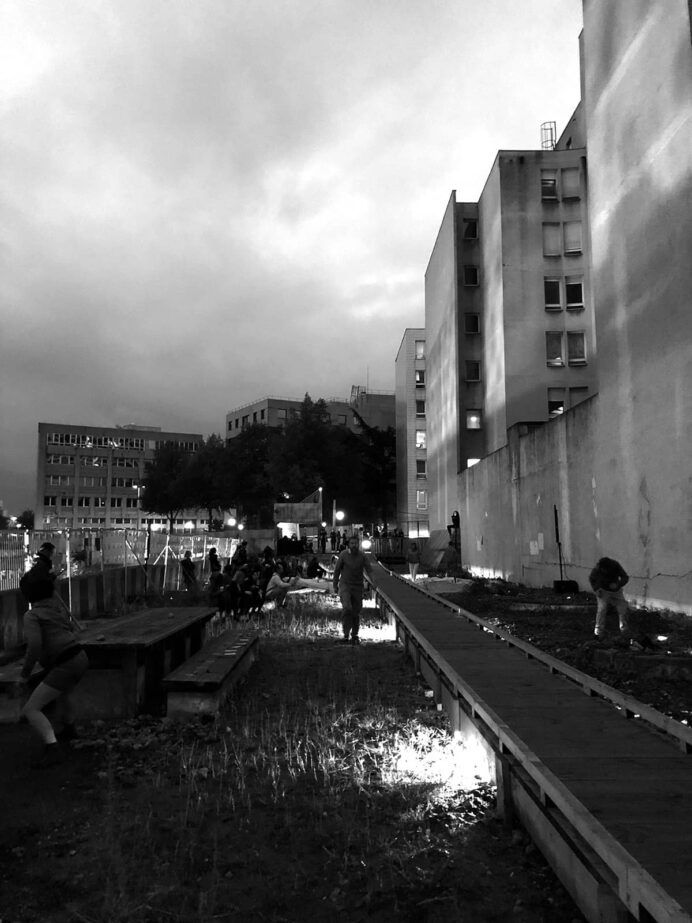Theatrum Mundi’s second Sonic Urbanism colloquium, held in Paris in 2019, culminated with a lecture and discussion between Saskia Sassen and opera director Alexandra Lacroix. The discussion traversed the disembodied language of algorithmic finance to the “fleshy” speech of bodies performing in Voie[e,x,s] – a project led jointly by Lacroix’s company MPDA and Theatrum Mundi. In this, the concluding text of Sonic Urbanism: The Political Voice, Theatrum Mundi’s director John Bingham-Hall reflects on the conversation and draws out new directions for sounding and listening in the city.
In asking “Does the city have speech?” Saskia Sassen provided the stimulus for the colloquium whose discussions have been shared through this publication. 1 The city, Sassen has argued, is still “a space where the powerless can make speech, presence, a politics”. But the city also has its own language: the “interactive deployment of people, firms, infrastructures, buildings, projects imaginaries, and more, over a confined terrain, produces something akin to speech”. 2 Her provocation that “the city talks back” sparked Theatrum Mundi to dig further into what political speech means, as a sonic phenomenon but also in many other forms of communication.
In a keynote lecture to conclude the colloquium, however, Sassen inverted this analysis with an account of buildings made assets and rendered speechless. Sharing the stage, opera director Alexandra Lacroix described a creative project, led together with Theatrum Mundi, that offers a counterpoint: performance can still be a way for the voices of the least powerful to mark their presence and to imbue silent spaces with a language that allows them to become inscribed with memory. Each of these readings rings true: the mediated algorithmic languages, through which financial markets extract value from the city, co-exist with everyday fleshy speech and the sonic presence of bodies in space. Through the voices of Saskia Sassen and Alexandra Lacroix, and by adding my own words, I want to ask whether we can bridge these realms of communication and engage performance as part of a sonic urbanism that resists the silencing of the city. 3
Cities have lost their innocence, if they ever had it
Cities are complex and incomplete systems with the capacity to outlive formal, closed systems. At the same time, they are open to a variety of interventions that might not be what we want – appropriations and abuses of power. (Sassen)
Clearly, there is no one urban speech. Cities have always been concentrations of communication. Some have existed as the gatekeepers to mythology, in which the words of monarchs or deities are (temporarily) immortalised in stone and ritual for interpretation by an elite on behalf of the “masses”. Many cities developed at the crossroads of international trading routes, or at the apex of empires, as administrative centres in which legal and financial records that govern those systems have been stored in media, from papyrus to code. Within London, both these logics intersect. Westminster is the seat of monarchical, religious and political powers that have imposed a ritualistic urban form, structured around monuments and axes intended for symbolic pageantry. What is now known as the Square Mile, on the other hand, was the historic mercantile City of London, an unplanned network that emerged slowly from the build-up of multiple processes of domestic, cultural and commercial spatial production. 4 In Westminster, control over both language and architecture was centralised and finalised. In the City of London itself, a multiplicity of spoken languages and communicative processes drove a constant evolution. It is this kind of incomplete and decentralised city (that London used to be) in which the powerless can claim space and, in Sassen’s words, “make a presence” through everyday spatial transformations. Yet the fluidity of this incomplete city also leaves it open to abuse.
Sassen’s research on extractive capitalism has highlighted a new kind of language that enables this abuse of open cities like London. She describes how algorithmic mathematics can be employed within the financial sector to translate almost any material form into an asset. Sylvain Bourmeau, chairing the discussion, added:
Katharina Pistor explains to us with new words how capital is created by computing code, with an incredible imagination to produce new products, new assets. She highlights the fact that, going back to material things, there are two regions of the world, two small regions: the City of London, and South Manhattan, which are the places in which people create this capital. The examples of New York and London are different from other places in the world, because they are places where the material and the immaterial are put together. 5
Specific, tiny zones of the world’s surface, of which the City of London is one, concentrate the expertise that can manipulate algorithmic languages to create global flows of economic liquidity, with buildings, and therefore places, as the underlying asset. This liquidity is traded through private bank-owned networks that are concentrated in cities, but through languages that are unreadable to their inhabitants. Through this process, the ownership and usage of buildings have become divorced and finance has transformed itself into the greatest concentration of wealth in the economies of advanced capitalism. Cities, as Sassen suggests, are subject to these processes and instruments within them, even places that lend themselves to it. Of course, cities are not just one thing – they are also home to the victims and the perpetrators of value extraction.
There is a kind of material world that is very much at play, but we cannot quite see it. Cities have become major places where this is happening. But they are also the places where those without power, the poor, can find a place. They can make a local community, a food-growing initiative… But the city is also now a site where very powerful actors can extract from this. (Sassen)
The ownership and usage of buildings have become divorced and finance has transformed itself into the greatest concentration of wealth in the economies of advanced capitalism.
Buildings can be traded in these invisible, unreadable networks, and this fact has fuelled a boom in the construction of skyscrapers, responding to an increasing demand for such assets from investors who may never set foot in the buildings they own. Massive amounts of very present, very physical material – the concrete and stone that increasingly tower over and surround us in cities – are implicated in these virtual transactions. Sassen’s research tracks 100 cities containing ten percent of the world’s population, but around 75 percent of foreign property investment. In Manhattan, she points to luxury towers containing so few people that their scant residents flee from loneliness. An empty building, Sassen points out, is a more desirable asset than one occupied by “troublesome” tenants. How do we look at buildings and understand what they are for when these logics have become so distanced from the experience of living in the city?
This is a brutal emergent history of capture, capture, capture, which we have trouble seeing and measuring. How do we begin to reconceptualise what the city is? What our eyes tell us is not enough. (Sassen)
Since 2005, tens of thousands of buildings have been purchased in London by obscure shell companies shielding the identities of foreign landlords. 6 What does it mean, Sassen asks, for tourists to come to London to gaze upon fine British buildings, when more of them are owned by the Qatari royal family than by the British Crown?
This is fine by the way, I don’t have a problem with that. The Queen will be fine. But it’s the loss of speech of the material. How do we know who owns buildings in our cities, when materiality cannot quite tell it as it is? We tend to assume we understand a material when we see it. (Sassen)
Cities are not just one thing – they are also home to the victims and the perpetrators of value extraction.
It is not just the iconic but removed landscapes of Manhattan or central London that provide the material basis for virtual wealth. The 2008 subprime loan crisis revealed how predatory lending had transformed people’s homes in suburbs across America into asset-backed risks to be traded amongst banks.
This is a real story. This is a story of the financial sector deciding that the 16 million households that did not own a house were entitled to do whatever it takes to own a house. So they produced an army of brokers and said “sign, you can own a house”. This was not about housing. This was about gathering a whole set of documents showing people had signed on to buy, which would allow the intermediaries to say “we have all these documents”. It was a fiction. It worked for the high-end investment sector, but it did not work for those households. 16 million lost their homes… over the period of five or six years. We cannot see the massiveness of it. It comes back to materiality – what does materiality stand for? What is the speech that it has or does not have? You cannot see with your eyes when 16 million households lose their home. In other words, the material loses speech.
In response to these horrors – because their effects on lives have been truly horrific – Sassen calls for new ways to cut across the languages that characterise knowledge silos. Truly urban spaces overlay formal and informal, emergent and defined, technical and artistic modes of communication. This is the source of their unique flexibility, but also the complexity that is misappropriated and even amplified
by the powerful to render them unreadable. Our fields of study of the city have not kept pace with this assemblage of language. Sassen calls for:
a tactical analytics, or an analytical tactics. This is not a descriptive effort, but an effort that moves inside a system and captures some elements. It cannot capture everything. It has within it the notion of destabilising meanings. Valuing and re-narrating these issues is critical. It is critical to find another language that can capture notions and be specific. Something that is delicate and needs to be handled with care but is another dimension. Not just the city, the buildings. Nor the abuse I have described. It is a language to capture the urban condition.
So how might art, and in this particular instance, opera, which has always been about expanding the voice so that everyday emotion becomes a public narrative, help develop this language?
As artists we can make the connection between planners, city, and citizens
Voi[e,x,s] is a project born from the discovery of an empty and silent place, Paris’ last great wasteland, and a desire to fill it with voices. It is a process of performance-making with its genesis in a workshop led by Alexandra Lacroix, artistic director of the opera company Cie MPDA, in collaboration with the tenor François Rougier, and organised by Theatrum Mundi. This workshop took place in Chapelle Charbon, a defunct rail depot at Paris’ deprived northern edge, with a group of practitioners working across sound and space, as well as the site’s guardian who shepherded the participants through wire fences and overgrowth and then lent his voice to our collective experimentations. The workshop asked: “what is a sociable acoustic?” 7 Lacroix responded by activating our bodies, tuning into the subtle sonic textures of the site’s emptiness, then expanding slowly into it by calling each other’s names across increasing distances. Names and soundscape combined – these became the basic material for a performance developed alongside the site’s transformation into a public park, due to open in autumn 2020 as this volume goes to print.
From these chance encounters, a process was set in motion by a meeting in 2017 between Theatrum Mundi’s Richard Sennett and John Bingham-Hall with Alexandra Lacroix and the composer Marta Gentilucci. Together, we formed a loose collective committed to a process of performance-making that would open up Chapelle Charbon as a space but also as an urban project to local inhabitants – for many of whom the space was unknown. In collaboration with landscape agency Taktyk, Alexandra Lacroix and her company invited citizens from local schools and social centres to help imagine the shape of a performance, exploring the site and its potentials through choreographed actions and performed vocalisations. Each participant contributed a recording of their name, building a library of voices to be amplified in the space. In June 2018 and October 2019, the project Voi[e,x,s] animated le Parc des 12 saisons, a temporary public space created by Taktyk on the site of Chapelle Charbon, already marked by traces left from these workshops, with performances combining these names with live vocalisations and recordings of the site’s materiality.
The first Crafting a Sonic Urbanism colloquium in 2018 was conceived as a platform to bring this project into dialogue with researchers and practitioners engaging sonic methodologies in city‑making. Its aim was to bridge exactly the silos identified by Saskia Sassen: of urbanism vs. sound studies, but also the relative silos of art-making and intellectual inquiry as modes of analysis. Richard Sennett, in his 2018 keynote, spoke alongside Alexandra Lacroix about the “cries of Paris”, placing Voi[e,x,s] within a long musicological history of voices of the city’s streets making their way into contemporary art. 8 The previous volume of this publication, published in 2019, included an essay describing the ways that performances of Voi[e,x,s] act as a kind of sonic urbanism. 9 They showed how the same patch of public space can go from feeling intimate and enclosed to epic and expanded as the composition by Marta Gentilucci moved from whispers to shouts and manipulated acoustic space, and Lacroix’s mise-en-scène took performers to the rooftops of surrounding buildings up to 500 metres apart.
As the project has continued, it has become clear it can also act as a platform for many kinds of dialogue that do not usually happen. As Alexandra Lacroix explains, music and sound can activate an awareness and physical engagement with others that the spoken voice alone cannot. As Jacques Rancière argues, the theatre is a place for the spectator to focus on and develop a position in relation to realities other than their own. 10 But the theatre might not be a sanctuary. Grounding a process of performance-making in public allows this sensorial activation of awareness to generate a strong relationality with an urban environment. Making oneself a focal point of attention, by performing in a space rather than simply “being” there, calls underlying dynamics into visibility, and demands negotiation with them.
This is particularly the case at Chapelle Charbon: a public site, the last metropolitan park that will be created in Paris, but also a politicised and contested territory that has been the stage for a politics of repeated migrant expulsions aimed at dismantling emergent migrant communities and solidarities. 11
For Voi[e,x,s], negotiations between long-term residents and temporary inhabitants, city government and artists, designers of temporary and permanent landscapes, were essential for making the work possible. By seeking permission for access, by “disturbing” neighbours who looked out of their windows to see what was happening, by navigating project timelines and trying to engage the site’s architects in incorporating a trace of the project in the design of the permanent park, Chapelle Charbon was made communicative.
As artists we can try to make the connection between the planners, the city, and then the citizens. Dealing with conflicts between communities, people’s goals and ideas, but also the ownership of spaces and hidden rules around their use – all these become part of the performance and enter into dialogue with each other in doing so. When working outside the theatre, therefore, “the city’s social and political controversies become the basis for the piece” (Lacroix).
Voi[e,x,s] takes as its sonic material the names of participants in the process of its creation, recorded in their own voices. “We already have 500 names and are aiming for thousands”, as Lacroix explained. The names are projected into the performance space as part of the electro-acoustic composition. For the final performance these will be combined by Marta Gentilucci with a palette of sounds recorded, in collaboration with researchers from IRCAM’s Perception et design sonores team, through a kind of sonic archaeology of materialities in the wasteland of Chapelle Charbon, before its demolition and redevelopment. Behind these choices lies a question that has driven us throughout:
how can a new public place become inscribed with memories and belonging, when it has been silent and unknown for so long? 12
When we have no agency over the physical transformation of a space, sound becomes a strategy. Speaking one’s name and hearing it echo back in a composition that fills the site with voices – this is one way to assert presence. Lacroix described the reality for many people she has encountered through the performance-making process, living in temporary shelters around Porte de la Chapelle, often for many years, but not considered citizens. Instead, she says, the language of war – invasion – is employed by many formally- housed residents to describe the presence of those in migration. Hearing and saying one another’s names, learning their etymological origins, is a starting point for encountering others through shared sensory experience that does not require the telling of troubled histories. The empty site of Chapelle Charbon is an opportunity to do this in a way that relates this social process to a site that becomes meaningful as a container for it.
The site speaks with the names of those that will have the opportunity to become its future users. The recording process is an important part. It is a way to give a voice to the speechless, to make relationships between inhabitants – permanent and temporary – and the site, to leave a trace. (Lacroix).
How can this kind of process speak back to the developments described by Sassen? Clearly, by making performance we cannot stop the liquidation of homes and built heritage into backstops for algorithmic finance. But it might be able to resist the resulting silencing of materiality that Sassen highlighted. It can make materiality itself resonate and force it into dialogue with those that live amongst it. In activating environments through “lively” processes of sound-making and gathering, otherwise hidden layers of administrative infrastructure that underpin the built environment – ownership, regulation and so on – might be made to reveal themselves. They might even be made vulnerable to the kind of questioning and destabilisation suggested by Sassen’s “analytic tactics”. This may not happen at scale, but each time a project like this embeds itself in a place and a network of communities, a small window into these underlying languages could be opened up. Publicly-sited creative processes can, as Voi[e,x,s] shows, act as platforms for unusual encounter between the complex range of knowledge and language silos implicated in urban transformation – when site manager, project lead and security guard come face to face with opera director, composer and inhabitant and performer to negotiate use of a site.
Finally, Voi[e,x,s] responds to a call by Sassen to take hold of sites like Chapelle Charbon to assert visibility and audibility where there is silence and obscurity. She points to:
the possibility of making presence where there is silence and absence. A variant of such making of presence is the terrain vague, an underutilised or abandoned space that lies forgotten among massive structures and construction projects[…] I think that this elusive in-between space is essential to the experience of urban living and that it lends legibility to transitions and the uneasiness of specific spatial configurations. We can find the terrain vague in even the densest city… They are the vacant grounds that enable residents who feel bypassed by their city to connect with it via memory at a time of rapid changes – an empty space that can be filled with memories. And it is where activists and artists find a space for their projects. This is a making of presence that is an act of speech. 13
Everyone speaks
There are many cities from the terrain vague to the offices of algorithmic finance and agency within each requires mastery of different languages. There are many media these languages can move through: private trading networks running through broadband cables; the voix (French for both a political kind of voice and for the vote with which that voice is expressed); the fleshy everyday acoustics of bodies, mouths forming names and the soundscapes of urban materiality; even, as our next colloquium will explore, in the sounds of non-human life and the ways that the public sphere might be re-imagined to include plants and animals as civic constituents.
The problem is not so much, then, “how can we have a voice?” Everybody speaks every day, whether vocally or through other forms of syntactic meaning. The problem is perhaps not even, or at least not only, “will we be heard?” Hearing guarantees nothing, and the preponderance of channels through which to express preference does not, as Nick Couldry argues, equal a society in which everyday narrations of experiences and desires are valued in politics. 14 The problem is a failure in dialogue between the increasingly abstracted realms of communication that extract wealth from urban systems and the daily vocalisations of those inhabiting those systems. The problem is a radical divergence in language between the data through which artificial intelligences guide urban decision-making and the words with which people express the pain inflicted upon them by these decisions. Cities are linguistically diverse spaces and we can learn to speak one another’s tongues. The communication failure comes in the loss of an everyday language with which to understand the forces shaping our environment. How can we connect the materiality of the kind of voice that forms Voi[e,x,s], with this fluid, invisible, algorithmic non-human systematised language of financialised real estate? If what our eyes tell us is not enough, then what about our ears – which can tune into a multiplicity of forms of presence in language but also in noise.
The answer might be exactly the “presence” described by Sassen. The proliferation of riot, civil unrest and occupation throughout the world in 2019 and 2020 is perhaps a symptom of an exhaustion with speech and a desire simply to be extremely, disruptively and radically present. Not politely asking for a response but making a noise so loud all other conversations have to stop, even if briefly. Performance is not the same as riot, but they share the potential of a flamboyant, noisy transgression of the everyday that might just sometimes force obscure voices to reveal themselves, to talk back.
- Sassen, Saskia. ‘Does the City Have Speech?’ Public Culture 25, no. 2 70 (1 March 2013) pp.209–21.
- Ibid. p.211.
- Unless another reference is given, all quotations marked Sassen or Lacroix are transcribed from their talks given at the Crafting a Sonic Urbanism: the Political Voice colloquium, December 13, 2019, Campus Condorcet, Paris.
- Bill Hillier, Space Is the Machine, (London, Space Syntax Ltd, 2004).
- Katharina Pistor, The Code of Capital: How the Law Creates Wealth and Inequality, (Princeton, Princeton University Press, 2019).
- Saskia Sassen, “Investment in Urban Land Is on the Rise – We Need to Know Who Owns Our Cities”, The Conversation, August 6, 2016, available online: theconversation.com/investment-in-urban-land-is-on-the-rise-we-need-to-know-who-owns-our-cities-63485. (Last accessed 20.07.20).
- Theatrum Mundi, “What is a sociable acoustic?”, Theatrum Mundi, available online: theatrum-mundi.org/programme/atelier-tm-first-workshop-what-is-a-sociable-acoustic. (Last accessed 03.08.20).
- See Sennett’s foreword “The Sonic City” in Theatrum Mundi and &beyond, (eds.) Sonic Urbanism, (London, Theatrum Mundi, 2019), pp.12–16;
See also Duncan MacLeod, “The Cries of London”, published in his volume pp.28-37. - Theatrum Mundi, “A score for a terrain vague”, Theatrum Mundi, available online:
theatrum-mundi.org/library/a-score-for-a-terrain-vague (Last accessed 03.08.20). - Jacques Rancière, The Emancipated Spectator, (London: Verso Books, 2014).
- Martina Tazzioli, “The Politics of Migrant Dispersal. Dividing and Policing Migrant Multiplicities”, Migration Studies, February 2019, available online: doi.org/10.1093/migration/mnz003 (Last accessed 20.07.20).
- Theatrum Mundi, “Site-specificity and sonic urbanism”, Theatrum Mundi, available online: theatrum-mundi.org/programme/atelier-tm-site-specificity-and-sonic-urbanism(Last accessed 03.08.20).
- Saskia Sassen, “Does the City Have Speech?”, Public Culture 25, no. 2 70 (March 1, 2013), pp.209–21.
- Nick Couldry, Why Voice Matters: Culture and Politics After Neoliberalism, (New York, SAGE, 2010).
